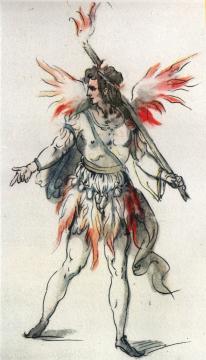|
|||||||||||||||||||||||||||||||||||
 |
|||||||||||||||||||||||||||||||||||
The Masque

The concept of the Masque is difficult to describe, because it has no exact modern equivalent, but in short, Masques were a blend of music, dance and drama created to celebrate a special occasion. They were usually extraordinarily lavish and spectacular affairs, and allegorical in nature, with figures from classical mythology playing out a scene written to resonate with the event they were celebrating.

The first occurrence of the word 'masque' occurs in 1513 in Hall's Chronicle where he describes a 'maske, a thing not sene afore in England', but it is known that masque-like entertainments, 'disguisings' or 'mumming', were performed at court in England from the reign of Edward III onwards. These entertainments became more and more elaborate in the reigns of Elizabeth and James I, and, absorbing influences from the Italian 'Intermezzo' and the French 'Ballet d'action', which 'owed as much to the skill of the painter and the sculptor as to that of the playwright and musician', the masque reached its heyday in the early seventeenth century. Descriptions of masques come down to us in the scripts of playwrights such as Ben Jonson, Beaumont and Thomas Campion (who wrote his own music). The music was written by the leading composers of the day: Campion, Ferrabosco, Lupo. The artist Inigo Jones, who had studied in Italy, left us plenty of designs for scenery and costumes, such as the fiery spirit to the left.
All manner of special occasions were celebrated with masques. Many of these were weddings, and these sumptuous, colourful performances make a truly magical and unique addition to a wedding day. They were also often used as grand entertainments for special visitors. The Earl of Cumberland gave one for James I during a royal progress, and when Elizabeth I visited Kenilworth Castle in 1575, she was treated to an elaborate water-borne pageant on the great lake. Our masques are thankfully nowhere near as costly as these events were (the cost of entertaining a King or Queen was so great as to bankrupt some hosts!) but they still make a spectacular and memorable addition to a celebration, whether the occasion is personal or that modern equivalent of a pageant for honoured guests, the corporate event.
While historically the Ante-masque was performed by professional actors, often the host or members of his household would take roles in the masque itself, or make up a group of costumed dancers. As princes, the future Charles I and his brother Henry often took part in masques staged by their father, James I. Hosts are welcome to be involved in our performances if they wish, (though this is by no means necessary) which can add to their guests' entertainment!
We can also provide something more subtle for quieter events: a quartet of musicians playing consort music, for example. Or something more raucous, such as a wooing play for an engagement party, perhaps.

